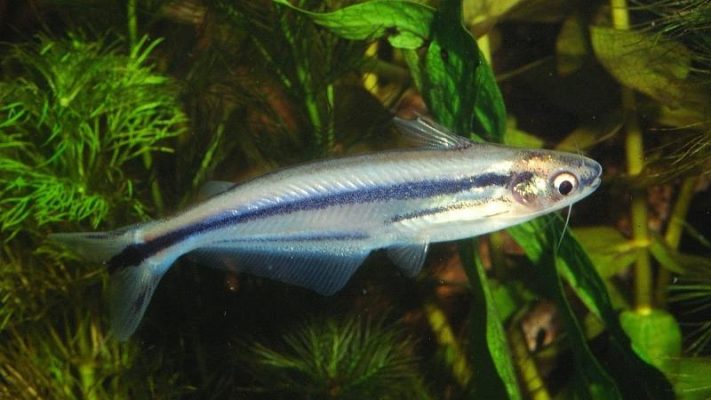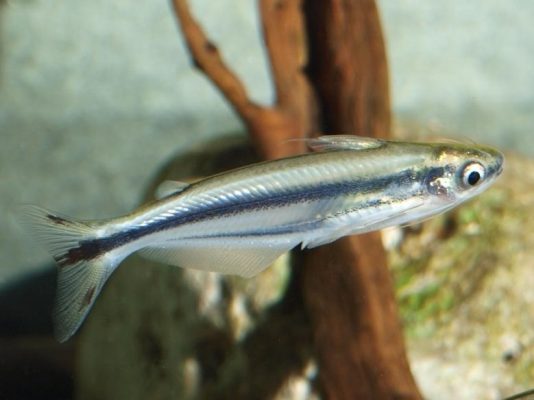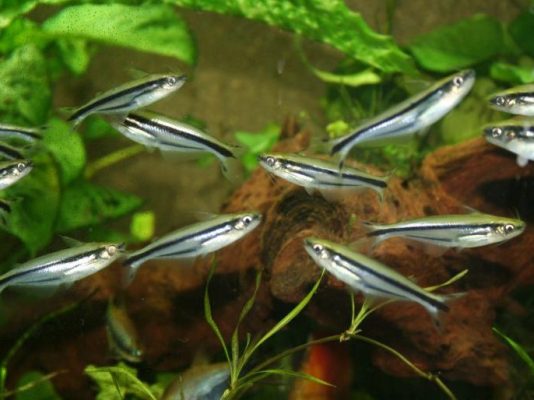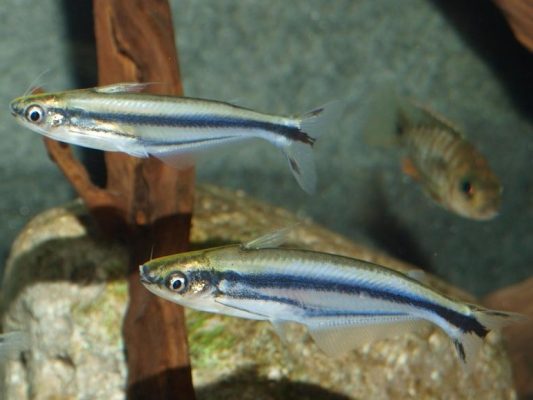Three-Striped African Catfish

Table of Contents
- Introduction
- Taxonomy and Classification
- Physical Description
- Behavior and Reproduction
- Diseases and Health Issues
- Preventive Measures
- Treatment Options
- Conclusion
- Conclusion
Introduction
The Three-striped African catfish (Pareutropius buffei) is a fascinating species that has captured the attention of aquarium enthusiasts worldwide. Found in the waters of Africa, this catfish species is known for its unique characteristics and attractive appearance. Its distinctive three stripes and vibrant coloration make it a sought-after addition to aquariums. In recent years, the popularity of the Three-striped African catfish in the aquarium trade has been steadily increasing, captivating both novice and experienced hobbyists alike.
Scientifically classified as Pareutropius buffei, the Three-striped African catfish belongs to the family Clariidae and the order Siluriformes. Its taxonomic history has seen notable revisions and updates, reflecting advancements in our understanding of this species. The origins of its common names can be traced back to its physical attributes and geographical distribution, adding significance to its identity.
The Three-striped African catfish boasts a striking appearance that sets it apart from other catfish species. It exhibits a sleek body structure, with an elongated shape and a flattened head. Growing up to a length of 15 centimeters, this catfish showcases a range of colors, including shades of silver, gray, and brown. However, what truly distinguishes it are the three prominent stripes that run horizontally along its body, giving it a visually captivating allure. Additionally, its caudal fin is uniquely shaped, enhancing its overall elegance.
In its natural habitat, the Three-striped African catfish is commonly found in rivers, lakes, and floodplains across Africa. It thrives in freshwater environments, favoring areas with moderate temperatures and pH levels. Specific regions and countries where this species is prevalent include the Congo River Basin, Niger River Basin, and Lake Tanganyika. To replicate its natural habitat in an aquarium setting, it is crucial to maintain appropriate temperature and pH levels, as well as provide adequate hiding spots and suitable substrate.
The Three-striped African catfish exhibits intriguing behavior and social interactions in the wild. It is primarily a nocturnal species, displaying increased activity during the night. As an omnivorous predator, it feeds on various prey, including insects, small crustaceans, and plant matter. The reproductive biology of this catfish involves mating behaviors and specific breeding strategies, which contribute to the continuation of its species. While it is generally a solitary species, it may form loose social structures under certain conditions.
Within its natural habitat, the Three-striped African catfish plays a significant ecological role. It interacts with other species, participating in predator-prey relationships and symbiotic associations. As a predator, it helps regulate populations of small aquatic organisms, contributing to the balance of the ecosystem. Furthermore, this catfish species is involved in nutrient cycling, aiding in the decomposition of organic matter. However, it is crucial to consider potential ecological impacts and conservation concerns, such as its vulnerability to environmental changes and the need for sustainable management practices.
The Three-striped African catfish holds economic importance in the aquaculture industry. It exhibits favorable growth rates, efficient feed conversion, and a degree of disease resistance, making it a valuable species for commercial production. Additionally, its popularity in the aquarium trade continues to rise, driven by its unique appearance and relative ease of care. However, it is essential for aquarists to maintain high water quality and provide proper filtration to ensure the well-being of this species in captivity.
The conservation status of the Three-striped African catfish is a matter of concern. Assessments conducted by the IUCN Red List or other relevant sources provide valuable insights into its current status. Habitat loss, overfishing, and pollution pose significant threats to the survival of this species. Efforts are underway to protect and preserve the Three-striped African catfish through various conservation initiatives. These initiatives aim to address the challenges it faces and promote sustainable practices to ensure its long-term survival.
Like any aquatic species, the Three-striped African catfish is susceptible to common diseases and health issues. It is important for aquarists to be aware of potential ailments and their symptoms. Implementing preventive measures, such as quarantine and proper hygiene, can minimize the risk of diseases. In the event of illness, various treatment options are available, emphasizing the importance of responsible ownership and proactive health management.
In conclusion, the Three-striped African catfish is a captivating species that offers unique characteristics and immense value to both aquarium enthusiasts and the ecosystems it inhabits. Its distinctive appearance, growing popularity, and ecological importance make it a species worth appreciating and protecting. Further research, conservation efforts, and responsible ownership are essential to ensure the long-term survival of this remarkable catfish. Let us join hands in safeguarding the beauty and diversity of our aquatic ecosystems, recognizing the significance of the Three-striped African catfish in this endeavor.
Taxonomy and Classification
Scientific Classification:
The Three-striped African catfish, scientifically known as Pareutropius buffei, belongs to the family Clariidae within the order Siluriformes. Its genus, Pareutropius, is derived from the Greek words “para” meaning “near” and “eutropius” meaning “well-turned,” referring to the fish’s close resemblance to the genus Eutropius. The species name, buffei, is a tribute to the French ichthyologist Léon Louis Buffe, who made significant contributions to the study of African catfish.
Taxonomic History and Revisions:
The taxonomic classification of the Three-striped African catfish has undergone several revisions over the years. Originally described as Clarias buffei by Boulenger in 1899, it was later reclassified as Eutropius buffei by Pellegrin in 1920. However, further studies and morphological analyses led to its placement in the genus Pareutropius, as recognized today.
Notable revisions in the classification of the Three-striped African catfish include the recognition of its distinct features, such as the three prominent stripes along its body, which differentiate it from other catfish species. These revisions highlight the importance of accurate taxonomic classification in understanding the evolutionary relationships and ecological roles of species.
Origins of Common Names and Significance:
The Three-striped African catfish is known by various common names in different regions. In English-speaking countries, it is commonly referred to as the Three-striped African catfish, which aptly describes its distinctive physical characteristic of three prominent stripes along its body.
In African countries, it is often called “Mbuna” or “Nkupi” in the local languages. These names hold cultural significance, as they reflect the close relationship between the local communities and the fish species. The names are often derived from the fish’s appearance, behavior, or ecological importance in the region.
Understanding the origins of common names is essential for effective communication and scientific research, as it allows researchers and enthusiasts to identify and refer to the species accurately. Additionally, it fosters a deeper appreciation for the cultural connections between humans and the natural world.
By providing a comprehensive overview of the taxonomy and classification of the Three-striped African catfish, including its scientific name, taxonomic history, and origins of common names, we gain a deeper understanding of this fascinating species. This knowledge serves as a foundation for further exploration of its physical characteristics, habitat, behavior, and conservation status.
Physical Description
The Three-striped African catfish, scientifically known as Pareutropius buffei, possesses a unique and captivating appearance that sets it apart from other catfish species. Its physical characteristics and adaptations make it a highly sought-after species among aquarium enthusiasts.
General Appearance and Unique Features
The Three-striped African catfish has a sleek and elongated body, typical of most catfish species. However, what truly distinguishes it are the three prominent vertical stripes that run along its body, giving it its name. These stripes are usually dark in color, contrasting beautifully against the lighter background coloration of the fish. The intensity of the stripes may vary among individuals, with some exhibiting bold and distinct lines, while others may have more subtle markings.
In addition to its striking stripes, this catfish species displays a range of attractive colorations. The body is often adorned with shades of silver, gray, or pale yellow, creating a visually pleasing contrast with the dark stripes. The combination of these colors and patterns makes the Three-striped African catfish a visually stunning addition to any aquarium.
Size, Coloration, and Body Structure
The Three-striped African catfish typically reaches a maximum length of around 10-15 inches (25-38 cm). However, it is worth noting that individual growth rates may vary depending on factors such as diet, water quality, and tank size. Juvenile catfish may initially exhibit a more subdued coloration, with the distinctive stripes becoming more pronounced as they mature.
The body structure of this catfish species is well-suited for its natural habitat and lifestyle. It has a streamlined shape, allowing it to navigate swiftly through the water. The head is relatively small and pointed, with a downward-facing mouth equipped with small, sharp teeth. These teeth aid in capturing and consuming its preferred prey, which primarily consists of small invertebrates and insect larvae.
Caudal Fin and Other Physical Features
The Three-striped African catfish possesses a well-developed caudal fin, which plays a crucial role in its movement and maneuverability. The shape of the caudal fin is generally forked, allowing for efficient propulsion through the water. This adaptation enables the catfish to swiftly navigate its natural habitat, which often includes fast-flowing rivers and streams.
In addition to its caudal fin, the catfish exhibits other physical features worth mentioning. It has a pair of pectoral fins located on either side of its body, which aid in stability and steering. The dorsal and anal fins, positioned along the upper and lower portions of the body, respectively, also contribute to the catfish’s overall balance and control.
Overall, the Three-striped African catfish’s physical description showcases its unique and visually appealing attributes. From its distinctive stripes and attractive coloration to its streamlined body structure and well-adapted fins, this species stands out as a remarkable addition to both natural habitats and aquariums.
Habitat and Distribution
The Three-striped African catfish, also known as Pareutropius buffei, is predominantly found in freshwater ecosystems throughout Africa. It inhabits a diverse range of habitats, including rivers, lakes, and floodplains, which provide ample opportunities for foraging and reproduction.
This species has a wide geographical distribution across Africa, with specific regions and countries where it is prevalent. It is commonly found in the rivers and lakes of West Africa, including the Niger and Senegal rivers. It is also present in the Chad Basin and the floodplains of the Congo River. The Three-striped African catfish has demonstrated its adaptability to various water bodies, showcasing its ability to thrive in different ecological conditions.
The catfish prefers specific environmental conditions that are crucial for its survival and well-being. It thrives in water temperatures ranging from 22 to 28 degrees Celsius (72 to 82 degrees Fahrenheit). The pH level of its natural habitat typically falls within the range of 6.5 to 7.5, indicating a slightly acidic to neutral water environment.
In an aquarium setting, replicating the natural habitat of the Three-striped African catfish is essential to ensure its health and longevity. Maintaining a stable water temperature within the preferred range and monitoring the pH levels is crucial. It is recommended to use a reliable aquarium heater to maintain the appropriate temperature and regularly test the water for pH levels to make necessary adjustments.
Additionally, the catfish requires ample hiding places and vegetation in its aquarium to mimic its natural habitat. Providing rocks, driftwood, and live plants will not only create a visually appealing environment but also offer hiding spots for the catfish to retreat to when feeling stressed or threatened.
It is important to note that the Three-striped African catfish is a highly adaptable species and can tolerate a range of water conditions. However, maintaining optimal conditions will help promote its overall well-being and reduce the likelihood of stress-related health issues.
By replicating the natural habitat of the Three-striped African catfish in an aquarium setting, aquarists can create a thriving and visually captivating environment for this species. Proper care and attention to water quality and environmental conditions will ensure the catfish’s well-being and allow aquarium enthusiasts to appreciate its unique characteristics and behaviors.
Behavior and Reproduction
Behavior and Feeding Habits
The Three-striped African catfish, also known as Pareutropius buffei, exhibits fascinating behavior and social interactions in its natural habitat. These catfish are primarily nocturnal, displaying heightened activity during the night when they actively forage for food. During the day, they seek shelter in submerged vegetation or crevices to avoid predators and conserve energy.
Feeding Habits
Feeding primarily on small invertebrates, the Three-striped African catfish is a benthic feeder. It scavenges along the bottom of rivers, lakes, and floodplains in search of prey. Its diet consists of various aquatic insects, crustaceans, and organic detritus. This species has been observed using its barbels, which are sensory organs located around its mouth, to efficiently locate and capture prey. The catfish’s unique feeding habits make it a valuable contributor to the ecosystem, as it helps regulate populations of small invertebrates and maintains the balance of the aquatic food chain.
Reproductive Biology and Mating Behaviors
The reproductive biology of the Three-striped African catfish is an intriguing aspect of its life cycle. These catfish are oviparous, meaning they reproduce by laying eggs. Breeding typically occurs during the rainy season when water levels rise, creating favorable conditions for spawning. Male catfish engage in courtship displays to attract females, which can involve chasing, fin flaring, and headbutting.
Once a female has been courted and is ready to spawn, she will lay her eggs on submerged vegetation or other suitable surfaces. The male then fertilizes the eggs externally by releasing his milt over them. The eggs are adhesive, allowing them to stick to the chosen substrate and remain protected until hatching. The male may guard the eggs to ensure their safety from potential predators.
Unique Behavioral Traits and Social Structure
The Three-striped African catfish exhibits several unique behavioral traits and habits that contribute to its success as a species. These catfish are known to be highly adaptable and can tolerate a wide range of environmental conditions. They have been observed forming loose aggregations, especially during feeding or breeding periods, suggesting a social structure that allows for cooperative behaviors.
While the Three-striped African catfish can be found in small groups, they are not considered highly social or group-dwelling species. Instead, they tend to be more solitary, with individuals maintaining their territories and foraging independently. However, during breeding seasons, temporary social interactions and aggregations may occur as males compete for females and engage in courtship rituals.
The catfish’s ability to adapt to various social dynamics and its unique feeding and reproductive behaviors contribute to its ecological success. Understanding these behavioral traits is crucial for the conservation and management of this species, as it allows us to develop strategies that promote its well-being and ensure its long-term survival.
In conclusion, the Three-striped African catfish exhibits fascinating behavior and reproductive strategies that contribute to its ecological importance. Its nocturnal feeding habits, benthic scavenging behavior, and adaptable nature make it a valuable contributor to the aquatic ecosystem. Furthermore, its reproductive biology, including courtship displays and adhesive egg-laying, highlights the species’ ability to adapt and ensure the survival of future generations. While the Three-striped African catfish may not exhibit highly complex social structures, its temporary aggregations during breeding periods demonstrate the importance of understanding its unique behavioral traits. By appreciating and protecting the beauty and diversity of this species, we can contribute to the conservation of our aquatic ecosystems and ensure the long-term survival of the Three-striped African catfish.
Diseases and Health Issues
The Three-striped African catfish, like any other aquatic species, is susceptible to various diseases and health issues. It is important for aquarium enthusiasts to be aware of these potential problems and take proactive measures to ensure the well-being of their catfish. In this section, we will discuss some common diseases and health issues that may affect the Three-striped African catfish, including their symptoms.
1. Ichthyophthirius multifiliis (Ich)
Ich is a common parasitic disease that affects many freshwater fish species, including the Three-striped African catfish. It is caused by a microscopic parasite known as Ichthyophthirius multifiliis. Infected fish may exhibit symptoms such as white spots on their skin and fins, increased mucus production, and scratching against objects in the aquarium. If left untreated, Ich can be fatal. Treatment options include raising the water temperature, adding salt to the aquarium, and using medications specifically designed to eliminate the parasite.
2. Fin Rot
Fin rot is a bacterial infection that primarily affects the fins and tail of fish. It can be caused by poor water quality, stress, or injuries. Symptoms of fin rot include frayed or disintegrating fins, redness, inflammation, and a loss of appetite. To prevent fin rot, it is crucial to maintain excellent water quality, provide a stress-free environment, and avoid overcrowding in the aquarium. Treatment involves improving water conditions, removing any affected tissue, and using antibiotics if necessary.
3. Dropsy
Dropsy is a severe condition characterized by the accumulation of fluid in the body cavity of the fish. It is often caused by bacterial infections, such as Aeromonas or Pseudomonas. Fish with dropsy may exhibit symptoms such as bloating, raised scales, pineconing (protruding scales), lethargy, and loss of appetite. Dropsy can be challenging to treat, and the prognosis is often poor. However, early detection and prompt treatment with antibiotics may improve the chances of recovery.
Preventive Measures
1. Quarantine
It is essential to quarantine new fish before introducing them to an established aquarium. Quarantine tanks provide an opportunity to observe and treat any potential diseases or infections without risking the health of the entire aquarium population. Quarantine periods typically last for a few weeks, during which the new fish can be closely monitored for any signs of illness.
2. Proper Hygiene
Maintaining good hygiene practices is crucial for preventing the spread of diseases in the aquarium. Regularly cleaning the aquarium, including the substrate, decorations, and filtration system, helps remove excess waste and reduces the risk of bacterial or parasitic infections. Additionally, avoiding cross-contamination between aquariums and equipment is essential to prevent the transmission of diseases.
Treatment Options
1. Medications
When treating diseases in the Three-striped African catfish, it is important to choose medications specifically formulated for catfish or those known to be safe for use in catfish species. Follow the instructions provided by the manufacturer and consult with a veterinarian or experienced aquarist if necessary. It is crucial to carefully monitor the fish during treatment and adjust the dosage or duration as needed.
2. Proactive Health Management
Responsible ownership involves proactive health management to minimize the risk of diseases and promote the overall well-being of the Three-striped African catfish. This includes providing a balanced and nutritious diet, maintaining optimal water quality, and regularly monitoring the fish for any signs of illness. Additionally, avoiding overstocking and providing adequate space for the fish to swim and hide can help reduce stress and prevent the onset of diseases.
Conclusion
Being aware of common diseases and health issues that may affect the Three-striped African catfish is crucial for aquarium enthusiasts. By recognizing the symptoms, taking preventive measures, and implementing appropriate treatment options, we can ensure the health and longevity of these beautiful catfish. Responsible ownership and proactive health management are key to maintaining a thriving aquarium and protecting the well-being of our aquatic companions.
Conclusion
In conclusion, the Three-striped African catfish (Pareutropius buffei) is a fascinating species that captivates aquarium enthusiasts with its unique characteristics and striking appearance. Throughout this article, we have explored the taxonomy, physical description, habitat, behavior, ecological role, aquaculture potential, conservation status, common diseases, and health issues of this remarkable catfish.
The Three-striped African catfish, scientifically classified as Pareutropius buffei, belongs to the family Clariidae and the order Siluriformes. Its taxonomic history has undergone revisions and updates, reflecting our evolving understanding of this species. The common names of this catfish have cultural significance and reflect its origin and distinctive features.
In terms of physical description, the Three-striped African catfish boasts a sleek body structure with a size that can range from small to medium. Its most prominent feature is the three stripes that run vertically along its body, giving it a visually striking appearance. Additionally, its coloration adds to its allure, with shades of silver, gray, and black blending together harmoniously. The shape and size of its caudal fin, as well as other physical features, further distinguish it from other catfish species.
The natural habitat of the Three-striped African catfish encompasses rivers, lakes, and floodplains across various regions in Africa. It thrives in specific environmental conditions, such as moderate temperatures and pH levels. Replicating these conditions in an aquarium setting is crucial for the well-being of this species.
Behaviorally, the Three-striped African catfish exhibits interesting social interactions and feeding habits in the wild. It is known to be a predator, preying on small aquatic organisms. Understanding its reproductive biology, including mating behaviors and breeding strategies, contributes to our knowledge of this species’ life cycle.
Ecologically, the Three-striped African catfish plays a vital role in its natural habitat. It interacts with other species, participating in predator-prey relationships and symbiotic associations. However, the species also faces conservation concerns, such as habitat loss and overfishing, which highlight the need for proactive conservation efforts.
The economic importance of the Three-striped African catfish in the aquaculture industry cannot be understated. Its growth rates, feed conversion efficiency, and disease resistance make it a valuable candidate for aquaculture. Furthermore, its popularity in the aquarium trade underscores the need for responsible ownership and proper care, including maintaining high water quality and appropriate filtration systems.
Assessing the conservation status of the Three-striped African catfish reveals the urgency to protect and preserve this species. Ongoing conservation efforts aim to mitigate the threats it faces, such as habitat loss, overfishing, and pollution. However, further research and increased conservation initiatives are necessary to ensure its long-term survival.
Like any living organism, the Three-striped African catfish is susceptible to common diseases and health issues. Recognizing the symptoms and implementing preventive measures, such as quarantine and proper hygiene, can minimize the risk of diseases. Responsible ownership and proactive health management are essential for the well-being of this species.
In conclusion, the Three-striped African catfish is a remarkable species that deserves our attention and protection. Its unique characteristics, popularity in the aquarium trade, and ecological importance underscore the need for further research, conservation efforts, and responsible ownership. By appreciating and safeguarding the beauty and diversity of our aquatic ecosystems, we can ensure the long-term survival of this captivating species and contribute to the overall health of our planet.



